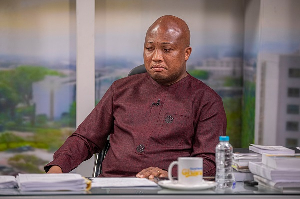This morning, Monday, 19 April 2021, the Ashanti Regional Minister, Simon Osei-Mensah (Honourable), granted a fatuous interview on ownership of lands in Ghana to Kwame Nkrumah Tikese on his “Ade akye abia” morning show programme.
He purports that all the lands in Ashanti region belong to Asantehene and that no family has any land in Ghana, especially, in the Ashanti region. He goes on to claim that there is nothing like family ownership of land in Ghana, especially, in the Akan-speaking areas of Ghana, and particularly, in the Ashanti region.
In law, all the lands belong to the chiefs and as such, all lands in Ashanti region belong solely to Asantehene but no one else. He kept hammering that no family has any land hence there is nothing like a family or clan land.
I beg to differ. Let me tutor this sycophantic Regional Minister who for his parochial interest and quest for power has always been rallying supportively behind the current Asantehene Otumfuo Osei Tutu II, in all his open and/or secret undertakings and dishonest activities.
Sir Francis Fuller (1866-1944) was the British Chief Commissioner of Ashanti from 1902 to 1920. He demarcated the Ashanti land among the various paramount chiefs. The paramount chiefs became the owners of the lands as were demarcated to them and mapped out with the supporting Fuller Pillars. Therefore, it is just erroneous and sycophantic on the part of Simon Osei Mensah to assert that every land in Ashanti region belongs to Asantehene.
Quoting from my previously published article, it reads, “During the restoration of the Asante Confederacy in 1935, the balkanization was somehow maintained as confirmed by a document of Draft by the Ashanti Confederacy Council signed on 21st day of March 1938”.
“The document states among other things, “Arising out to the Council discussion on Item 7 of the Agenda, the following declaration of custom is submitted to the Council for discussion and for signature if approved”.
1) “All land in Ashanti is the property of the stools of the various chiefs.”
“This said document was signed by Asantehene, Asantehemaa, Mamponghene, Juabenhene, Nsutahene, Bekwaihene, Kokofuhene, Adansihene, Kumawuhene, Essumenjahene, Offinsohene, Ejisuhene, Agonahene, Bandahene, Wenchihene, Nkoranzahene, Jamanhene, Mohene, Abeasehene, Berekumhene, Denyasehene, Asokorehene, Oyokohene of Kumasi, Kyidomhene of Kumasi, Gyasehene of Kumasi, Ankobiahene of Kumasi, Adontenhene of Kumasi, Benkum Clan of Kumasi, representative of Akwamuhene of Kumasi and Korentihene of Kumasi”.
From the above, how can the entire land in Asahanti region belong to Asantehene? The land belongs to the paramount chiefs as are demarcated and mapped out to them by Sir Fuller during the colonial days and approved by the Asante Confederacy Council on 21st March 1938.
In furtherance of my argument, it is stated clearly that “Allodial land title is held or vested in traditional stools or skins, in some traditional areas. Allodial owners hold their interest under customary law and are not subject to any restrictions on their use rights or any obligations except for those imposed by the law (statutory law)”.
Any interested reader can refer to sub-section “XIII Ownership of Land” in page 72 of Warrington Notes on Ashanti Custom written by J. N. Matson, L. L. B., Ag. Judicial Adviser. One will ascertain that the entirety of Ashanti land does not belong to Asantehene as is fallaciously dubiously being asserted by the Ashanti Regional Minister.
The lands as were demarcated to the paramount chiefs are in effect owned by families and clans. We have family lands within the entire land under a paramount chief despite the classification of the entirety of the land as a stool land for the paramountcy or division within Ashanti region.
In order not to waste anyone’s time, let me narrate this short litigation case and how it went.
In the mid-1960s, Kumawuhene Barima Otuo Acheampong ceded a vast land on the Kumawu-Abotanso road to the then Ghana Workers Brigade for their usual farming project. One Opayin Yaw Amponsah took the case to court. He claimed the land as belonging to his family hence his. This litigation went on for a while but in the end, he won the case. He kicked out the Workers Brigade from the land. It was a huge land on the right-hand side of the road, extending all the way from Kumawu to the outskirts of Abotanso.
It was on this land that in 1969 or thereabout, a rainstorm caused a big tree by the roadside to snap or uproot to kill two of the Workers Brigade staff. One was a pregnant woman and the other a man.
We used to take some rest under the tree whenever we were returning from farm from Abotanso to Kumawu.
Why could Opayin Yaw Amponsah win the case against Kumawuhene and the Workers Brigade over the ownership of the land if families do not own lands but solely the chief or Asantehene?
Asantehene does not own all the lands in the Ashanti region as is wrongly claimed by the sycophantic Simon Osei Mensah. Asantehene only owns the land in the Kumasi division that is directly under him as Kumasihene but not as Asantehene.
I have a personal story to tell to prove to the whole world that Asantehene Otumfuo Osei Tutu II himself is aware that the entire Ashanti region land does not belong to him.
Opinions of Monday, 19 April 2021
Columnist: Rockson Adofo
Ashanti Regional Minister Simon Osei Mensah goofs on ownership of lands in Ghana
Entertainment


















